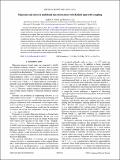Majorana end states in multiband microstructures with Rashba spin-orbit coupling
Author(s)
Potter, Andrew Cole; Lee, Patrick A.
DownloadPotter-2011-Majorana end states.pdf (563.3Kb)
PUBLISHER_POLICY
Publisher Policy
Article is made available in accordance with the publisher's policy and may be subject to US copyright law. Please refer to the publisher's site for terms of use.
Terms of use
Metadata
Show full item recordAbstract
A recent work [ Potter and Lee Phys. Rev. Lett. 105 227003 (2010)] demonstrated, for an ideal spinless p+ip superconductor, that Majorana end states can be realized outside the strict one-dimensional limit, so long as (1) the sample width does not greatly exceed the superconducting coherence length and (2) an odd number of transverse subbands are occupied. Here we extend this analysis to the case of an effective p+ip superconductor engineered from a Rashba spin-orbit-coupled surface with induced magnetization and superconductivity, and find a number of additional features. Specifically, we find that finite-size quantization allows Majorana end states even when the chemical potential is outside of the induced Zeeman gap where the bulk material would not be topological. This is relevant to proposals utilizing semiconducting quantum wires; however, we also find that the bulk energy gap is substantially reduced if the induced magnetization is too large. We next consider a slightly different geometry, and show that Majorana end states can be created at the ends of ferromagnetic domains. Finally, we consider the case of meandering edges and find, surprisingly, that the existence of well-defined transverse subbands is not necessary for the formation of robust Majorana end states.
Date issued
2011-02Department
Massachusetts Institute of Technology. Department of PhysicsJournal
Physical Review B
Publisher
American Physical Society
Citation
Potter, Andrew, and Patrick Lee. “Majorana End States in Multiband Microstructures with Rashba Spin-orbit Coupling.” Physical Review B 83.9 (2011) : 094525. ©2011 American Physical Society.
Version: Final published version
ISSN
1098-0121
1550-235X